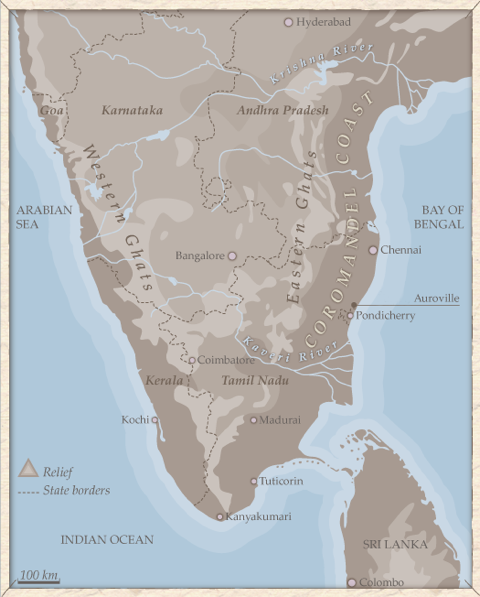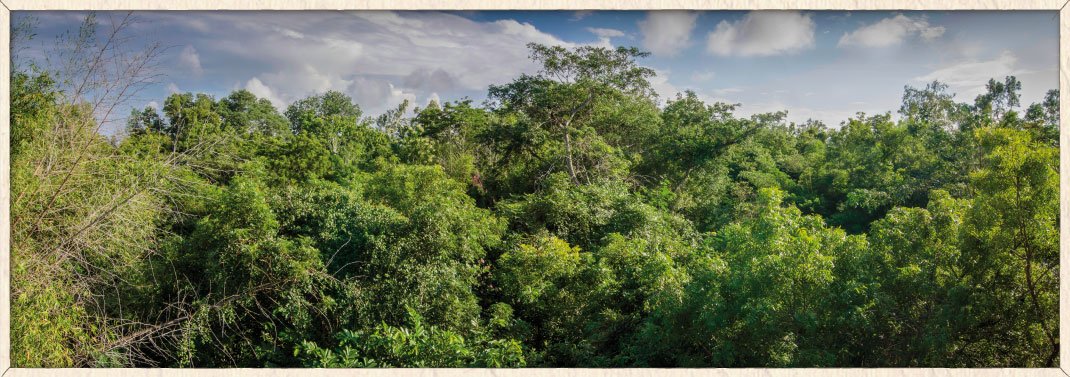The specimens of this herbarium have been collected in the forests and bioregion of Auroville, Tamil Nadu.
Digital samples of plants found in this virtual herbarium include :
- Local, vulnerable and sometimes endangered species of the native Tropical Dry Evergreen Forest (TDEF) of the Coromandel Coast
- Widespread species of the Indian subcontinent, some of which originated on other continents and were spread by humans throughout the tropics (such as the Tamarind, the Neem or the Banyan)

The Tropical Dry Evergreen Forest (TDEF) is the functional description of the original forest of the Coromandel Coast of South East India, from Visakhapatnam in the north, to Point Calimere in the south. Historically, it extended as a belt of vegetation between 30 and 50 kilometres wide, bordered on one side by the sea, and on the other by a forest that becomes increasingly deciduous as one moves inland.
This forest is characterized by trees and shrubs that have thick, dark evergreen foliage, although there are also some notable deciduous trees. In general, the trees and shrubs are slow-growing, and the wood is dense and hard. In its pristine state, it is a tightly woven matrix of vegetation about 6 metres high, with the occasional emergent tree rising above the canopy to 10 metres. It contains over 160 woody species, and when one includes all the lianas, epiphytes, herbs, and tuberous species that grow in a variety of ecological niches within the range of the forest, the number of species approaches 1,000. Of these, over 600 have a recorded use, for either medicinal, cultural, or religious ritual. When undisturbed, these forests form a complex diverse habitat that is home to a myriad of animal species, mammals, birds, reptiles, amphibians, and insects.
These days, the forests of the Coromandel Coast are under severe threat, with less than 5% of the original forest range remaining. The majority of these are now classified as secondary forest regrowth areas, having been cleared in the previous century as woodlots. Since only a small percentage of these remnant forests exist in anything near to pristine condition, this original forest type is considered the most endangered of all Indian forest types. Further stress on these forests are brought about as this area is both heavily populated and agriculturally intensive, with substantial grazing pressure from domestic livestock.
The international community of Auroville began in 1968 on an eroded and degraded plateau 12 kilometres north of the city of Puducherry. For the early settlers of Auroville, it was clear that the major imperative was to stop the loss of soil to the rains through water harvesting, and to create shelter from the sun and the dust storms by planting trees. From these early experiments in afforestation, multiple plant species were identified to be able to withstand the extreme climatic conditions. This was largely responsible for the success of the Auroville forests today, with approximately two million trees now growing in over 2,000 acres. Over the past 25 years, reforestation techniques have been refined to include extensive use of native plant species and much has been done to conserve this forest type in the greenbelts of Auroville, as well as in allied projects around Tamil Nadu. To support this, important research has been carried out, including establishing the species that make up the matrix of the original forest, collecting information when each species flowers and fruits, and developing techniques to germinate and raise the species in nurseries to plant out, either as enrichment plantings in already-existing forest, or to rehabilitate bare and barren land. There is still much work to be done to further protect and restore the biodiversity of the Auroville bioregion.
